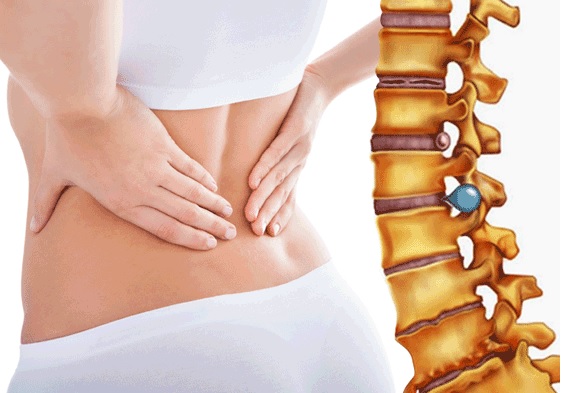 Life & Style
Life & Style

A portion of spine disc pushes outside from normal position of spinal vertabra, this is called a herniated disc. Herniated disc normally occurs following traumatic agents or when the disc becomes less elastic and more rigid due to degeneration and rupture. On clinical signs is manifested a neuropathic pain.

|
What is a herniated disc?
We have 24 movable vertebrae in our spines (from the cervical spinal vertebrae to the lumbar vertebrae) and between them are discs.
The spinal disc consists of an anunus fibrosus with a central nucleus pulposus (gelatin). This helps keep the spine flexible and support for our body movement normally.
A portion of spine disc pushes outside from normal position of spinal vertebra, this is called a herniated disc. Herniated disc normally occurs following traumatic agents or when the disc becomes less elastic and more rigid due to degeneration and rupture. On clinical signs is manifested a neuropathic pain.
Herniated disc may occur in any part of the spine, but it is common in the lumbar spine that leads to lower back pain. If the slipped disc presses on the nerve, root pain can be felt in the low part of the back and spread into the leg (also called low back pain with sciatica).
A herniated disc in the neck can cause neck pain. If it does not compress on the nerves that go to the arm, the sufferer will experience pain in the neck, shoulders and arm on the same side.
Patients with no symptoms can also not be aware of this condition when compression on the nerve roots is not present.
Who is more likely to get a herniated disc?
Herniated disc often occurs in people aged from 35 to 55, more common in men. It could be because intense physical activities, strenuous sport activities or work factor are involved, men are more likely to be affected by this condition.
What are the main causes?
Degenerescence: Degenerative disc increases with ages. As you get older the spine loses its strength, flexibility and you may lose height by time.
Sudden movement or wrong postures when lifting heavy objects that cause the spine to be twisted.
Overweight people or pregnant women: higher pressure produced on the spine.
Family history: many family members suffer from herniated disc, even young people due to the weakness of the spine and discs.
When should you see a doctor?
You are recommended to see a neurologist immediately when you:
Experience pain in the lower back for more than one week that affects the sufferer’s daily activities.
Feel painful after an accident or trauma
Suffer pain at night
Have pain with fever and lose weight for no apparent reason
This condition will be normally stable after 4 to 6 weeks of treatment and good care. If no progress is made, a new treatment plan should be applied.
Emergency cases include back pain with sphincteral disorders (urinary retention, incontinence or weakened extremities).
What are the symptoms?
Current imaging studies enable us to detect a herniated disc which can be symptomatic or asymptomatic. A case of herniated disc may have the following symptoms:
Paroxysmal pain after muscle stimulation of bending, sneezing or making an effort. Pain may increase while sitting for a long period, standing or lying down.
A herniated disc in the lower back produces back pain with or without pain along the sciatic nerve.
Neck pain and numbness are symptoms of a herniated disc in the neck. Pain can extend to shoulders and arm (normally on one side) along with arm numbness and arm heaviness or weakness.
Who is at risk?
Those who do heavy work activities or play strenuous sports.
Pregnant women and obese people. People with weak muscles.
People who have family history of herniated disc.
How to prevent a herniated disc?
A herniated disc can be prevented by:
Healthy lifestyle,
Do regular physical exercises,
Do exercises to strengthen muscles of the body, back and abdominal muscles,
Maintain your BMI within the normal range.
Correct postures
Stand: Hold your head up straight, look forward and keep the shoulder blades a little back.
Lift: Do not bend over or force your back to lift heavy thing off the ground. The proper way to lift is to bend at the knees, keep the back straight and hold close to the body.
Dig: Keep your back straight by stepping one leg forward and keep your knees bending slightly.
At work
If you must stand for long periods, use a low stool to rest your legs. Put one leg on the stool while standing. Change the leg every 5 – 10 minutes.
Take a rest after prolonged sitting to avoid muscle strain.
Sit in a straight-back chair and keep your back straight
Put your legs a little higher than your hips while sitting. Rotating chair should be used.
Attentions
It’s better to wear your handbag on the shoulders than hold it by hand.
To move a heavy object, you should push it rather than pull it.
Avoid putting on extremely high-heel shoes. Shoes with soft soles are advised.
Patient with symptoms of a herniated disc should meet a neurologist for a consultation. If surgery is required, he or she will be referred to a neurosurgeon. — Hanoi French Hospital
If you have any questions or want to book an appointment with our doctors, please contact us at our phone number 84 – 24.3577.1100, or email us at contact@hfh.com.vn

|